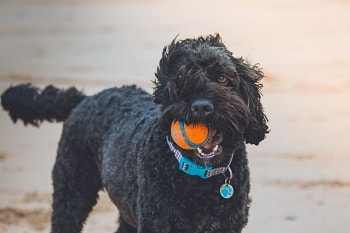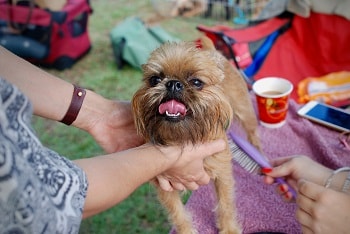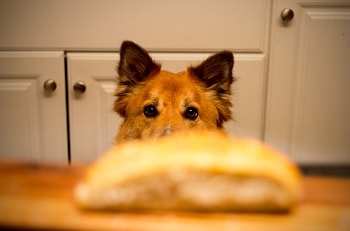If you feel as if you are vacuuming your dog’s hair all the time, you may need extra measures to minimize shedding. All dogs shed, except hairless breeds.
More than just a nuisance, hair shedding can be a problem for dog owners with allergies or asthma. The Asthma and Allergy Foundation of America (AAFA) says 3 in 10 people have an allergy to cats and dogs. While pet’s hair is not an allergen, it can carry the pet’s dander, urine, and saliva, which can cause a reaction in allergic individuals. The dander may also have other allergens like dust and pollen.
A Dog’s Hair Cycle

Just like humans, dogs shed hair too. Their hair goes through a cycle of growing and shedding. The rate of shedding varies according to several factors like their breed, health status, and age.
Dogs may be double-coated. They may have undercoats and topcoats. Topcoats comprise of the coarse hair strands that you feel on the outside. The undercoat is made up of hair that’s closest to the dog’s skin. This protects them from cold climates. Examples of double-coated dogs are Siberian Husky, Golden Retriever, and Pomeranian.
Double-coated dogs experience what is called a “coat blow.” This is when the greatest hair shedding occurs. The hair falls in clumps, not in strands. It happens around spring or fall.
Hypoallergenic Dogs: Do They Exist?
The AFFA says there are no non-allergic dogs. People with allergies just react differently to dog breeds. It’s the pet’s urine, saliva, or dander that causes allergies.
Pet owners with allergies may suffer from chronic cough or itchy eyes. This is because allergens may remain on surfaces, including clothing, curtains and bedsheets long after the pet has left the area. When you clean these surfaces, pet allergens may become airborne and it can remain in the air for a long period of time.
What people refer to as hypoallergenic dogs are those that don’t shed as much hair as double-coated dogs. These are also perfect for those who want to minimize cleaning time for dog hair. The breed is a factor that you’d want to consider if you want to minimize shedding.
Here are examples of hypoallergenic dogs:
- Poodle
- Yorkshire Terrier
- Shih Tzu
- Maltese
- Giant Schnauzer
- Basenji
- Havanese
- Bichon Frise
- Irish Water Spaniel
- Kerry Blue Terrier
Ways to Minimize Dog Shedding
Dog shedding can’t be stopped completely. It is also not advisable to shave your dog’s hair because it can affect your dog’s ability to regulate their body temperature. There’s also a risk for the hair to not grow back.
The best way to manage shedding is to catch the hair as soon as they fall. If you don’t suffer from a dog allergy and you want to minimize or manage dog shedding, here are tips to follow:
1. Perform routine grooming. Routine grooming includes hair brushing, nail trimming, bathing, ear cleaning, and having haircuts. How often a dog should be groomed also depend on the type and breed of your dog. In general, dogs should bathe at least once a month.
Getting the services of a professional dog groomer can also help minimize shedding as they bathe your pet, dry his hair and brush his hair to get rid of dead hair and restore its shine. Note that the grooming place may be more stressful for dogs than the procedure itself. Car rides can make the dog anxious. Training your dog and making him used to get handled will help reduce the stress associated with grooming.
2. Brush your dog’s hair regularly. The brushing schedule depends on your dog’s hair type. Long-haired dogs need to be brushed daily. Medium-haired ones need to be brushed at least once a week. Short-haired ones need to be brushed at least once every two weeks. Brushing prevents matting, tangling, and excess shedding. When it’s time for dogs to shed, brushing frequently gets rid of dead hair before they fall off.

When choosing your dog’s brush, you need to check your dog’s coat. Here are the types of brushes that help with removing loose hair:
Slicker Brush: Great for long to medium hair and curly hair. It effectively removes loose hair and undercoat. Gently use this brush to avoid damaging the hair and scratching your pet’s skin.
Undercoat rake: Great for double-coated dogs with thick hair. It works so to remove loose fur easily and dead hair easily. It also prevents matting.
Rubber brush: Great for short-haired dogs that tend to shed excessively. The rubber material attracts loose hair before they fall to the ground. It also massages the dog’s skin to encourage healthy hair growth. It can also be used as a shampoo brush.
Moulting comb: These combs have two-length pins that work great for double-coated dogs and those with thick hair. Long pins help get rid of the knots while the short pins remove the dead hair.
De-shedder: This brush is particularly designed for shedding. It removes more dead hair than other types of brushes. This is ideal for double-coated dogs with thick coats.
3. Restrict dog access. Limiting the areas where your dogs play will not minimize shedding, but it will prevent dead hair and pet dander from spreading all over your place. This is especially important if you or your family members have a pet allergy. Keep your dogs away from your bedroom. Designate an area where your dogs can roam, eat, and play. Consider getting a dog playpens for your pet.
4. Feed your dog the right food. Proper nutrition and hydration can help prevent excessive shedding. Adding moisture and omega-3s to its diet also promotes healthy skin and coat.
Too much shedding may signal a health problem. If you notice excessive hair loss or bald patches along with skin irritation, open sores, and frequent scratching, consult your veterinarian. Excessive shedding can be also caused by other factors like food allergies, infections, parasites, diseases, sunburn, or pregnancy.

5. Clean promptly. As soon as you notice your dog shedding hair, vacuum the area. Use a lint roller to pick up freshly dropped hair from your clothes and furniture. This is easier to remove than hair that’s been there for a long time. Damp rubber gloves may also be used to remove pet hair from fabric. Consider using an air purifier with HEPA filter to get rid of airborne dander.
